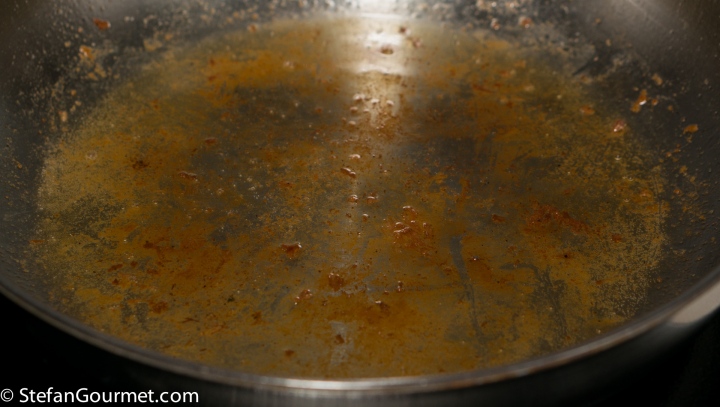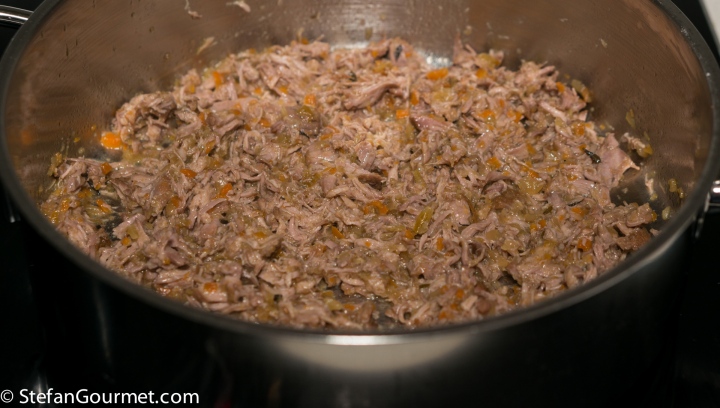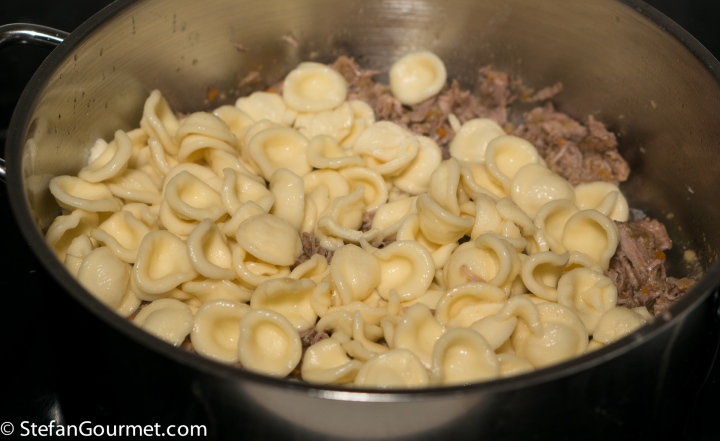Still more food from our trip to Southern Italy last September. We had dinner in Puglia at Già Sotto l’Arco, and one of the dishes there was orecchiette with a lamb ragù and cream of ricotta. The cream of ricotta is a very nice addition that takes the whole dish to the next level. It turns out that this cream is surprisingly easy to make. So easy in fact, that I bet it is a lot easier than what you are thinking right now, even after I just wrote how surprisingly easy it is 🙂 In the photo above it is a bit difficult to see the cream of ricotta, as the plate is also white.
Most ragù in Italy is made with tomatoes, but it is also common to make it without and then call it “in bianco” (white). Without tomatoes you can taste the lamb better. Recently I posted another recipe for lamb ragù sous vide, for which I used the meat grinder. In this case I cooked the lamb in large chunks and then used two forks to ‘pull’ it after it had been cooked. I like the texture of the ragù, with strands of tender meat, better this way. If you don’t have sous-vide equipment, you could obtain a similar result with a bit more effort by stewing the meat on the stovetop or in the oven, using very low heat. This means regular stirring and adding (hot) water as needed. With sous-vide you can just drop it in and forget about it for 24 hours, and it will come out perfect every time.
The previous recipe I mentioned above included a cream of smoked eggplant. I bet it would be nice to have both types of cream on the plate.
Ingredients
For 4 servings
For the ragù
700 grams (1.6 lbs) lamb neck
1 celery stick, 1 onion, 1 carrot, minced
some fresh thyme
125 ml (1/2 cup) dry white wine
3 Tbsp olive oil
salt and freshly ground black pepper
For the pasta and cream of ricotta
300 to 400 grams (.66 to .9 lb) orecchiette
250 grams (1 cup) ricotta
salt
Instructions
Cut the meat into thick slices across the grain.
Season them on all sides with salt and freshly ground black pepper.
Brown the meat on all sides in 3 tablespoons of olive oil over high heat.
Take the meat out of the pan and reserve on a plate. There will be a lot of flavor stuck to the bottom of the pan.
Add the minced onion, carrot, and celery, and the thyme. Season with a bit of salt.
Stir over medium heat until the vegetables have dried out and start to color. (Recipes in Italian often use the expression of letting the aromatics dry out, and I think it is a good description of what is supposed to happen.)
Deglaze with the white wine.
Bring the wine to a boil and allow to simmer for a minute, then turn off the heat and allow to cool. If using the type of vacuum sealer that is not good with liquids, freeze this mixture.
(If not using sous vide, this is where to add the meat and hot water and simmer until the meat is tender.)
(If using ziplock bags for sous-vide, there is no need to cool. Just mix the meat with the vegetables, put it in the ziplock bag, close with the water displacement method, and cook sous-vide.)
The meat should be cooled off completely in the refrigerator before vacuum sealing.
Add any juices that have collected on the plate on which the meat cooled to the vegetables. We don’t want to waste any flavor.
Vacuum seal the meat together with the vegetables. I did this in two portions, as there were only two of us for dinner and this is ideal to freeze. (You can thaw and reheat by heating the frozen bag at 74C/165F for approximately 3 hours. This time is sufficient only if you flattened the bag before freezing.)
Cook sous-vide for approximately 24 hours at 74C/165F.
The next day, bring a pot of water to a boil, add salt, and the orecchiette. Cook for the time indicated on the package for al dente.
In the meantime, take a bag of lamb ragù out of the sous-vide…
…and dump the contents into a pan. Discard any thyme branches (but leave in any leaves).
Transfer the meat to a cutting board and get two forks.
Pull the meat apart using the forks.
Bring the liquid in the pan to a boil.
Add the pulled lamb, then immediately turn off the heat.
Stir to mix the meat with the juices.
To make the cream of ricotta, put the ricotta in a saucepan over low heat.
Add a bit of the pasta cooking water, about a quarter of the amount of ricotta. Do not add too much at once, as you can always add more later.
Use an immersion blender to mix the ricotta with the cooking water and beat in some air. Add more pasta cooking water if needed. Taste if any more salt is needed (probably not, as both the ricotta and pasta cooking water are already salty.)
And that’s it! That’s all it takes to make a lovely cream of ricotta.
When the pasta is done, drain it, but reserve some of the cooking water. Add the drained orecchiette to the ragù.
Toss to mix, adding some of the reserved cooking water if needed to keep it moist.
Taste and adjust the seasoning with salt and freshly ground black pepper.
Serve the pasta on preheated plates with the cream of ricotta on the side.
Wine pairing
At Già Sotto l’Arco the similar dish was paired with a fizzy Frappato (red). A creamy pinot noir (i.e. not an astringent one) would also work, or many other medium bodied reds that are not too astringent. An oaked and aged white would also be excellent.
Flashback
Madeleines are classic French small cakes that have to be slightly crispy on the outside and fluffy on the inside, with a wonderful aroma of either vanilla, citrus zest, or, as in this case, almonds.





























Great walkthrough as ever Stefan. I must try lamb neck one of these days.
LikeLiked by 1 person
So pleased again you ended up in Southern Italy last year as you have provided some of the most interesting Italian recipes I have from that holiday! Have not made ragu from lamb, have not enjoyed the ridiculously easy ricotta cream . . . but now have both on the agenda soonest . . . oh, by the ‘ancients’ method naturally 🙂 !
LikeLiked by 1 person
This is lovely! The lamb, the cream sauce, the pasta… really nice.
LikeLiked by 1 person
Ma tutti questi ristoranti sanno di essere stati celebrati da te così degnamente? Sarebbero contenti
LikeLiked by 1 person